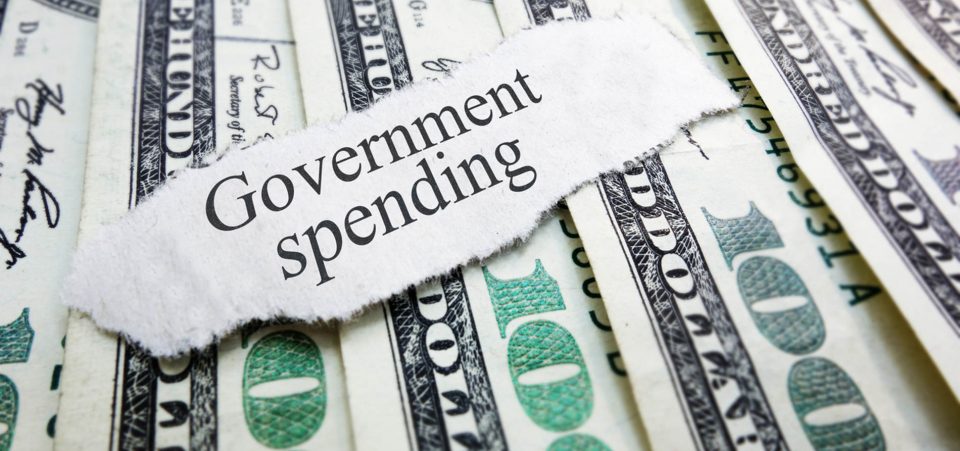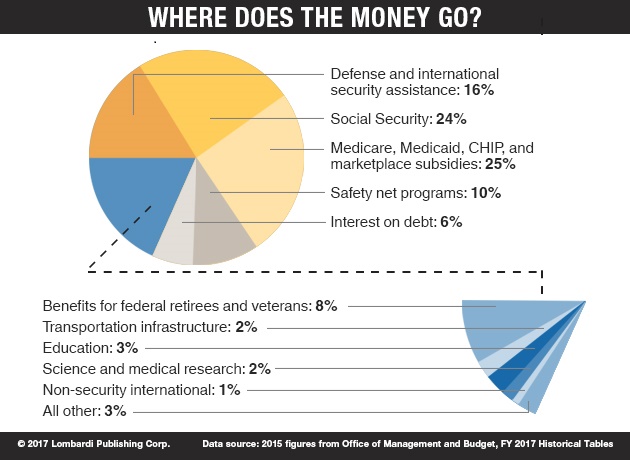U.S. Government Spending Forecast for the Next Five Years
President Donald Trump wants to buy many weapons during his first term in office. That means the U.S. government spending forecast for the next five years has a significant military component. President Trump has asked for a 10% increase in defense spending on behalf of the Pentagon for the new fiscal year.
The increased U.S. government spending on the military is not a surprise. Trump pledged to make America safer and to “keep the terrorists away” during his first address before Congress. Trump has also launched an anti-ISIS plan, which could lead to an escalation of military involvement in Iraq and Syria. Yet, health and social security costs are going to rise.
The problem with military spending is that the media overwhelmingly tends to report increases rather than the total. In 2015, the total military budget was said to amount to $598.0 million. That accounts for a significant portion of all discretionary spending. There are two categories of spending: “mandatory” and “discretionary.”
Mandatory spending involves programs such as Medicare, social security, the military, cabinet departments such as the U.S. Department of Justice, and agencies such as the U.S. Securities and Exchange Commission (SEC). Mandatory spending programs were adopted through acts of Congress.
In fiscal-year 2018, the mandatory budget amounts to $2.696 trillion, and it’s just about two-thirds of all U.S. government spending. Social security will consume ever more taxpayer dollars, because so many of the so-called baby-boomers will retire in the next few years. (Source: “Current U.S. Federal Government Spending,” The Balance, March 22, 2017.)
Note the government spending chart below. There are many mandatory costs that cannot be cut without significant bipartisan approval.
U.S. Government Spending: Social Security Costs More Than Defense
Social Security already exceeds a trillion dollars in costs. Over the next few decades, it will account for an ever larger drain of total U.S. government spending. Medicare and Medicaid together account for another trillion or so dollars, while the military absorbs a large portion of the remaining $695.0 trillion or so. (Source: Ibid.)
Indeed, a government spending breakdown shows that defense accounts for a large chunk, but not the largest. Let’s consider the spending chart above. Note that Defense and International Security account for 16%. That’s huge compared to what other countries spend on defense. But it’s not the biggest consumer of U.S. taxpayers’ dollars.
Most of current government spending goes to Medicare, Medicaid, and related subsidies (25%); and Social Security (24%). What should raise everyone’s concerns is the spending that goes nowhere: interest on the public debt. That alone accounts for six percent of total U.S. government spending. Of course, it does not even begin to pay the principal.
It’s no wonder many economists worry about the U.S. GDP forecast for 2017. President Trump wants to increase spending on infrastructure and cut it on social services. But the tax breaks he has promised to so many sectors of society make that all but impossible to achieve. Especially as the isolationist policies he proposes could backfire.
However, Trump has history on his side. Considering U.S. government spending by year; the decade between 1940 and 1950 saw the highest spending as a percentage of GDP. In that period, government spending exceeded 50% of GDP. That was the period of World War II. The problem is that even after the dramatic fall of spending after that war, the trend has been to spend more.
There was a slight dip in the rising trend during the Bill Clinton era, but the 2007–2008 recession played havoc with Social Security, and there was a sharp rise in government spending in the 2009–2010 period. Obamacare may also have played a role in boosting government spending in 2009, when President Barack Obama signed it into law. It didn’t become operational until October 2013.
Could Obamacare Signal Trump’s Inability to Curb Spending?
Obamacare could become one of the policies that will damage President Trump’s chances of re-election in 2020. The problem is that Trump made a rather big deal of Obamacare. He criticized it to such an extent that repealing it was going to serve as one of his administration’s signature achievements for 2017. But Congress voted not to repeal Obamacare.
The costs of healthcare and social security have surged. Keeping Obamacare might not be such a bad policy for the country, but it will be a major setback for President Trump. On March 24, 2017, Trump found out that being president and especially making promises during a presidential campaign have little in common.
Lifting Obamacare would have given Trump kudos for taking action against runaway U.S. government spending. Instead, it has become a setback and a humiliation, as Trump himself had to withdraw the proposal that he proposed to replace Obamacare (“Trumpcare?”), at the request of Republican House Speaker Paul Ryan.
Trump could not get 216 votes needed to move the new healthcare bill to the Senate. The markets are going to feel the effect of this failure. Relegating Obamacare to the dustbin of history—as Trump hinted he would do—was going to show just how effective the machinery of state would work under Trump and a united Republican government.
Instead, it all went in the wrong direction, and all too fast. Obamacare stays and so do all the tax dollars it absorbs, making it more difficult for Trump to achieve his program. Meanwhile, the markets have been rivaling Elon Musk and SpaceX in their ambitions to reach outer space, expecting major tax cuts.
Obamacare will be a word and policy destined to outlive Trump’s first term. The markets might soon hit the wall of reality and realize that President Trump and Paul Ryan can’t simply expect an automatic republican majority. Most of all, it shows that Trump has no coherent plan to cut spending in such a way as to secure a majority in Congress.
Indeed, what the Obamacare debacle has shown is that President Trump has enemies among his own party. They might be willing to challenge him on every major decision involving government spending. That’s the best way, in fact, to embarrass the president with his voter base. The danger is that Trump might go after Obamacare in other ways.
He could sign decrees to reduce the percentage of total U.S. government spending that the program absorbs. But that would be risky because, whether Republican or Democrat, many Americans like Obamacare. Or at least they prefer it to the alternative. Thus, repealing it without replacing it with something better will not work.
The solution is to keep it and, more than that, improve it. This may not work to keep government spending down during his first term, but a better Obamacare could end up encouraging more Americans to receive preventative healthcare. Regular checkups that detect problems early, while they’re still cheaper to treat, could be the only way to curb spending on healthcare.
Republicans and Democrats Are Both Addicted to Government Spending
Still, the problem of government spending reaches the very root of what being an American is about. In the United States, few would dare question the concept of capitalism. Even Americans who subscribe to the official left positions—the Democratic Party—accept many of the ideas of capitalism. Supposedly, this acceptance of capitalist values by the Left should have helped keep government spending in check.
Why is this important? Because it suggests that Americans have a natural and built-in mechanism to resist excessive government interference in their lives. There has been general bipartisan agreement on rejecting the notion that the government should, or even could, resolve individual citizens’ problems from cradle to grave.
That, by the way, is the idea behind socialism. Americans, even those who subscribe religiously to The Nation or donate to PBS, are hardly socialists. But government spending, even as both Democrats and Republicans have always tended toward increasing it, is a major source of partisan divide in the United States.
Thus, Americans agree that the government should neither be building cars or selling savings accounts. Yet they can still disagree on the extent that the federal government should intervene in the economy. One of the biggest related problems is the amount of taxes it collects, and how it spends them. The Trump Republicans say they believe that the federal government must refrain from any interventionism. Thus, they insist that government spending must be drastically reduced. They see that as the only way to reduce the tax burden.
Democrats and Republicans once had different views on government spending. The Republicans and their Federalist ancestors advocated government spending to facilitate state investment. The Republicans favored the concept of a central bank and of federalizing public debt in order to build the vast infrastructure to develop America.
If that sounds familiar it’s because Trump’s plan resembles it. Rather, the Democrats, at least during a majority of the 19th century, advocated small government. It represented the rural interests—the very same interests that the Democrats have seemingly ignored lately.
Still, traditional Democrats representing the “New Deal” spirit, like Bernie Sanders, have called for a more active role of the government in the economy. That means more government spending. The result is that, in one way or another, all parties tend toward boosting government spending. The Republicans support it if it favors the business world; the Democrats support it if it protects the most fragile elements of society.
Democrats and Republicans share the American Dream. That’s the idea that a talented individual can succeed (in the economic sense), regardless of who the person is and where he or she was born. The idea is that a poor person can become rich in America, regardless of who’s president. That’s the American sense of equality, which differs sharply from its socialist counterpart, whereby nobody, not even the talented, can enjoy outlandish wealth.
Partisan divisions, however, emerge when what one gets into the details of what this “equality” means. That’s what the debate over government spending is about. Thus, Trump, a Republican, thinks spending on defense will contribute to the upholding of American “equality.”
For Trump, reviving the glory days of U.S. military power and actually raising the stakes in the arms race with Russia will benefit many American workers and taxpayers. But, so far, despite the efforts, U.S. government spending is destined to keep increasing. That means, sooner or later, the markets will react bearishly, realizing Trump has little room to apply budgetary and fiscal reforms.







